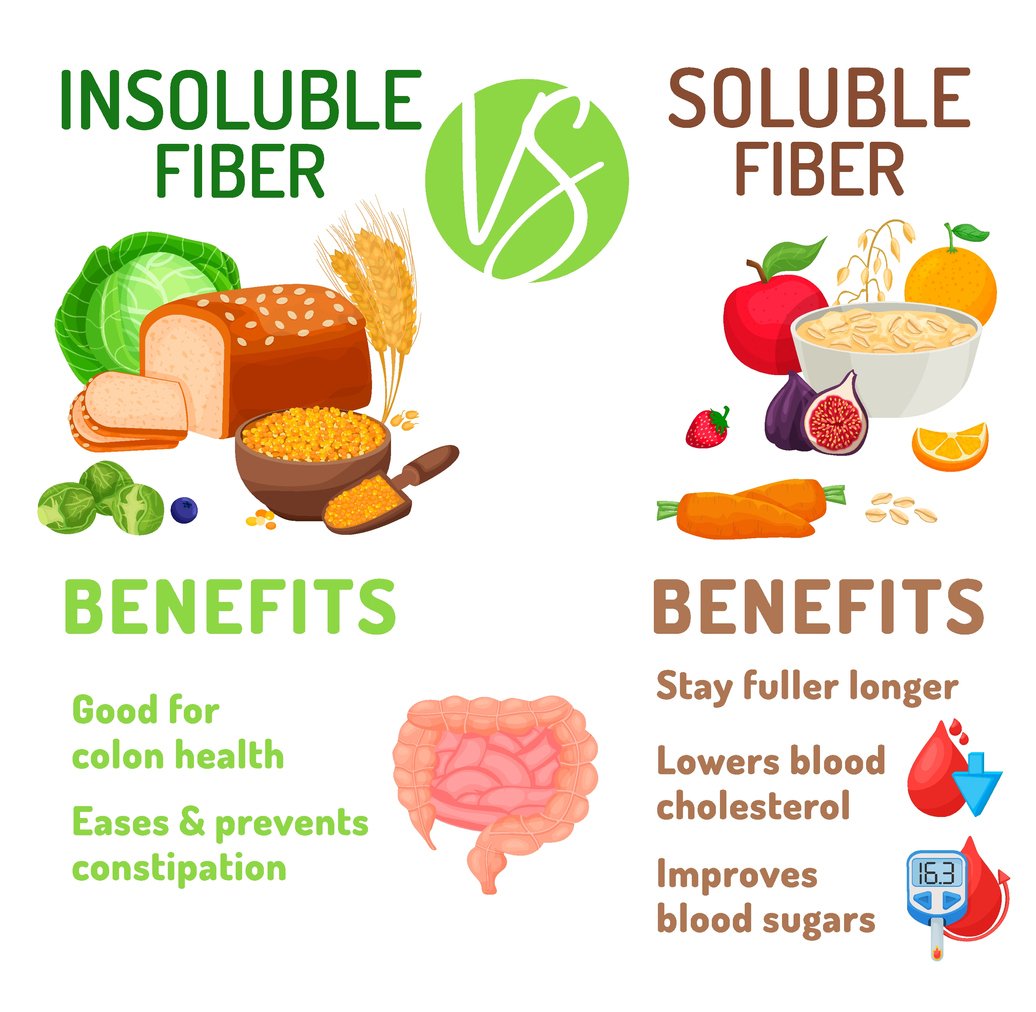Insoluble fiber, unlike soluble fiber, does not dissolve in water and remains almost unchanged throughout the digestive process. They are found in wheat bran, nuts, beans and vegetables such as cauliflower, green peas and potatoes. Insoluble fiber helps to bulk up stool and move it through the digestive tract, making it particularly useful for preventing constipation and maintaining healthy bowel function.
Both types of fiber are essential for good health and each has a unique role in the body. Soluble fiber benefits the cardiovascular system by lowering bad cholesterol and helping to control blood sugar, while insoluble fiber supports a healthy digestive system, prevents constipation, and supports regular bowel movements.
In addition, fiber contributes to a longer feeling of satiety, which can help control weight and prevent overeating. Adequate fiber intake is associated with a lower risk of various diseases, including heart disease, diabetes, colon cancer, and other digestive disorders. As a result, a healthy eating plan should include a variety of foods that are rich in both types of fiber to ensure maximum health benefits.
Fiber, especially soluble fiber, has a significant effect on blood cholesterol levels, which can help reduce the risk of cardiovascular disease. Soluble fibers such as beta-glucan, found in oats, barley, beans, apples and citrus fruits, work by absorbing water and forming a gel-like substance in the digestive tract. This gel binds to bile acids, which are made from cholesterol, and helps remove them from the body. Since the body needs bile acids for digestion, it starts using more cholesterol to make them, thus lowering the total cholesterol in the blood.
Effects of fiber on cholesterol levels:
Thus, adding more fiber to your daily diet, especially soluble fiber, can significantly lower blood cholesterol, reduce the risk of heart disease, and support overall health.

Dietary fiber plays an important role in regulating blood pressure and maintaining a healthy circulatory system, thus helping to reduce the risk of cardiovascular disease. Soluble fibers such as beta-glucan, found in oats, barley, beans, apples, and citrus fruits, are effective in lowering blood pressure through several mechanisms.
Effects of fiber on blood pressure and circulatory system:
Regular and sufficient consumption of fiber significantly lowers blood pressure and improves the condition of the circulatory system. Due to its multifaceted positive effects, fiber is an indispensable part of a healthy diet that helps prevent cardiovascular diseases.
Regular consumption of fiber is an essential factor in preventing atherosclerosis, a disease caused by the accumulation of cholesterol and other fats in the walls of the arteries, forming atherosclerotic plaques. These plaques narrow and harden the arteries, disrupt blood flow and can lead to heart attacks or strokes. Fiber works in several ways to help reduce the risk of atherosclerosis.
The effect of regular fiber consumption on the prevention of atherosclerosis:
Cholesterol reduction
Soluble fibers such as beta-glucan bind cholesterol and bile acids in the digestive tract, helping to remove them from the body. This encourages the body to use more cholesterol to make bile acids, thereby lowering total blood cholesterol and LDL ("bad") cholesterol levels. Lower LDL cholesterol directly reduces the risk of atherosclerotic plaque formation.
Antioxidant effect
Fiber-rich foods such as fruits, vegetables, nuts, and grains are also rich in antioxidants that help fight free radicals and reduce oxidative stress. Oxidative stress is one of the main factors that promote the formation of atherosclerotic plaques, because oxidized LDL cholesterol particles accumulate more easily in the arterial walls.
Reducing inflammation
Fiber has an anti-inflammatory effect, which is important for the prevention of atherosclerosis. Inflammatory processes in the arterial walls promote the formation and growth of plaques. Fermentable fibers such as inulin and pectin are broken down in the large intestine into short-chain fatty acids such as butyrate, which have strong anti-inflammatory effects.
Blood sugar regulation
Fiber helps stabilize blood sugar levels by slowing glucose absorption. Stable blood sugar levels help prevent insulin resistance and metabolic syndrome, which are important risk factors for atherosclerosis. Insulin resistance promotes the accumulation of fat in the walls of the arteries, so its prevention is very important.
Body weight regulation
Regular consumption of fiber helps maintain a healthy body weight, as fiber provides a feeling of fullness and reduces the risk of overeating. Obesity is one of the main risk factors for atherosclerosis, as it is associated with increased levels of cholesterol, triglycerides and blood pressure. A healthy body weight reduces the load on the cardiovascular system.
Improving blood circulation
Fiber supports a healthy gut microbiota, which affects the body's overall inflammation and circulatory system. A healthy microbiota produces short-chain fatty acids that can improve vascular function and elasticity, reducing arterial stiffness and improving blood flow.

So, regular consumption of fiber not only lowers cholesterol, but also has many other health benefits that together help prevent atherosclerosis. Integrating high-fiber foods into your daily diet can significantly reduce your risk of cardiovascular disease and support your overall health.
# skaidulos # aterosklerozė